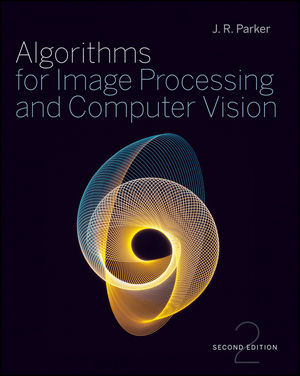Algorithms for Image Processing and Computer Vision, 2nd EditionISBN: 978-0-470-64385-3
Paperback
504 pages
December 2010
 |
||||||
Preface xxi
Chapter 1 Practical Aspects of a Vision System — Image Display, Input/Output, and Library Calls 1
OpenCV 2
The Basic OpenCV Code 2
The IplImage Data Structure 3
Reading and Writing Images 6
Image Display 7
An Example 7
Image Capture 10
Interfacing with the AIPCV Library 14
Website Files 18
References 18
Chapter 2 Edge-Detection Techniques 21
The Purpose of Edge Detection 21
Traditional Approaches and Theory 23
Models of Edges 24
Noise 26
Derivative Operators 30
Template-Based Edge Detection 36
Edge Models: The Marr-Hildreth Edge Detector 39
The Canny Edge Detector 42
The Shen-Castan (ISEF) Edge Detector 48
A Comparison of Two Optimal Edge Detectors 51
Color Edges 53
Source Code for the Marr-Hildreth Edge Detector 58
Source Code for the Canny Edge Detector 62
Source Code for the Shen-Castan Edge Detector 70
Website Files 80
References 82
Chapter 3 Digital Morphology 85
Morphology Defined 85
Connectedness 86
Elements of Digital Morphology—Binary Operations 87
Binary Dilation 88
Implementing Binary Dilation 92
Binary Erosion 94
Implementation of Binary Erosion 100
Opening and Closing 101
MAX—A High-Level Programming Language for Morphology 107
The ‘‘Hit-and-Miss’’ Transform 113
Identifying Region Boundaries 116
Conditional Dilation 116
Counting Regions 119
Grey-Level Morphology 121
Opening and Closing 123
Smoothing 126
Gradient 128
Segmentation of Textures 129
Size Distribution of Objects 130
Color Morphology 131
Website Files 132
References 135
Chapter 4 Grey-Level Segmentation 137
Basics of Grey-Level Segmentation 137
Using Edge Pixels 139
Iterative Selection 140
The Method of Grey-Level Histograms 141
Using Entropy 142
Fuzzy Sets 146
Minimum Error Thresholding 148
Sample Results From Single Threshold Selection 149
The Use of Regional Thresholds 151
Chow and Kaneko 152
Modeling Illumination Using Edges 156
Implementation and Results 159
Comparisons 160
Relaxation Methods 161
Moving Averages 167
Cluster-Based Thresholds 170
Multiple Thresholds 171
Website Files 172
References 173
Chapter 5 Texture and Color 177
Texture and Segmentation 177
A Simple Analysis of Texture in Grey-Level Images 179
Grey-Level Co-Occurrence 182
Maximum Probability 185
Moments 185
Contrast 185
Homogeneity 185
Entropy 186
Results from the GLCM Descriptors 186
Speeding Up the Texture Operators 186
Edges and Texture 188
Energy and Texture 191
Surfaces and Texture 193
Vector Dispersion 193
Surface Curvature 195
Fractal Dimension 198
Color Segmentation 201
Color Textures 205
Website Files 205
References 206
Chapter 6 Thinning 209
What Is a Skeleton? 209
The Medial Axis Transform 210
Iterative Morphological Methods 212
The Use of Contours 221
Choi/Lam/Siu Algorithm 224
Treating the Object as a Polygon 226
Triangulation Methods 227
Force-Based Thinning 228
Definitions 229
Use of a Force Field 230
Subpixel Skeletons 234
Source Code for Zhang-Suen/Stentiford/Holt Combined Algorithm 235
Website Files 246
References 247
Chapter 7 Image Restoration 251
Image Degradations—The RealWorld 251
The Frequency Domain 253
The Fourier Transform 254
The Fast Fourier Transform 256
The Inverse Fourier Transform 260
Two-Dimensional Fourier Transforms 260
Fourier Transforms in OpenCV 262
Creating Artificial Blur 264
The Inverse Filter 270
The Wiener Filter 271
Structured Noise 273
Motion Blur—A Special Case 276
The Homomorphic Filter—Illumination 277
Frequency Filters in General 278
Isolating Illumination Effects 280
Website Files 281
References 283
Chapter 8 Classification 285
Objects, Patterns, and Statistics 285
Features and Regions 288
Training and Testing 292
Variation: In-Class and Out-Class 295
Minimum Distance Classifiers 299
Distance Metrics 300
Distances Between Features 302
Cross Validation 304
Support Vector Machines 306
Multiple Classifiers—Ensembles 309
Merging Multiple Methods 309
Merging Type 1 Responses 310
Evaluation 311
Converting Between Response Types 312
Merging Type 2 Responses 313
Merging Type 3 Responses 315
Bagging and Boosting 315
Bagging 315
Boosting 316
Website Files 317
References 318
Chapter 9 Symbol Recognition 321
The Problem 321
OCR on Simple Perfect Images 322
OCR on Scanned Images—Segmentation 326
Noise 327
Isolating Individual Glyphs 329
Matching Templates 333
Statistical Recognition 337
OCR on Fax Images—Printed Characters 339
Orientation—Skew Detection 340
The Use of Edges 345
Handprinted Characters 348
Properties of the Character Outline 349
Convex Deficiencies 353
Vector Templates 357
Neural Nets 363
A Simple Neural Net 364
A Backpropagation Net for Digit Recognition 368
The Use of Multiple Classifiers 372
Merging Multiple Methods 372
Results From the Multiple Classifier 375
Printed Music Recognition—A Study 375
Staff Lines 376
Segmentation 378
Music Symbol Recognition 381
Source Code for Neural Net Recognition System 383
Website Files 390
References 392
Chapter 10 Content-Based Search — Finding Images by Example 395
Searching Images 395
Maintaining Collections of Images 396
Features for Query by Example 399
Color Image Features 399
Mean Color 400
Color Quad Tree 400
Hue and Intensity Histograms 401
Comparing Histograms 402
Requantization 403
Results from Simple Color Features 404
Other Color-Based Methods 407
Grey-Level Image Features 408
Grey Histograms 409
Grey Sigma—Moments 409
Edge Density—Boundaries Between Objects 409
Edge Direction 410
Boolean Edge Density 410
Spatial Considerations 411
Overall Regions 411
Rectangular Regions 412
Angular Regions 412
Circular Regions 414
Hybrid Regions 414
Test of Spatial Sampling 414
Additional Considerations 417
Texture 418
Objects, Contours, Boundaries 418
Data Sets 418
Website Files 419
References 420
Systems 424
Chapter 11 High-Performance Computing for Vision and Image Processing 425
Paradigms for Multiple-Processor Computation 426
Shared Memory 426
Message Passing 427
Execution Timing 427
Using clock() 428
Using QueryPerformanceCounter 430
The Message-Passing Interface System 432
Installing MPI 432
Using MPI 433
Inter-Process Communication 434
Running MPI Programs 436
Real Image Computations 437
Using a Computer Network—Cluster Computing 440
A Shared Memory System—Using the PC Graphics Processor 444
GLSL 444
OpenGL Fundamentals 445
Practical Textures in OpenGL 448
Shader Programming Basics 451
Vertex and Fragment Shaders 452
Required GLSL Initializations 453
Reading and Converting the Image 454
Passing Parameters to Shader Programs 456
Putting It All Together 457
Speedup Using the GPU 459
Developing and Testing Shader Code 459
Finding the Needed Software 460
Website Files 461
References 461
Index 465



